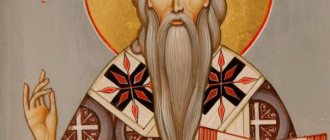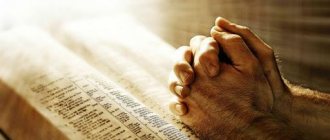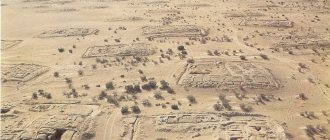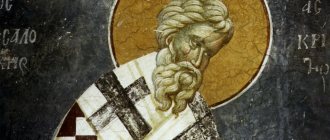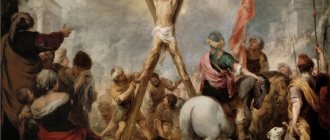Hieromartyr Hypatius, Bishop of Gangra, was the bishop of the city of Gangra in Paphlagonia (Asia Minor). In 325, he took part in the First Ecumenical Council in Nicaea, at which the heresy of Arius was anathematized.
When Saint Hypatius was returning from Constantinople to Gangry in 326, he was attacked in a deserted place by followers of the schismatics Novatus and Felicissimus. The heretics wounded him with swords and stakes and threw him from a high bank into a swamp. Like the first martyr Archdeacon Stephen, Saint Hypatius prayed for those who were killing him. One Arian woman hit the saint on the head with a stone, and he died. The killers hid the body of the martyr in a cave, where it was discovered by a peasant who stored straw there. Having identified the body of the bishop, he hastened to report this to the city, and the inhabitants of Gangra honorably buried the relics of their beloved archpastor.
After his death, the relics of Saint Hypatius became famous for numerous miracles, especially the casting out of demons and the healing of diseases.
Troparion of the Saint, tone 3.
In the beautiful Church of the Apostolic Vertograd, from a young age, you were planted by the all-powerful right hand of God, God-blessed Father Hypatius, and in it, like a faithful high priest, you truly preached the Divine and All-Creating Trinity Unity in the Ecumenical Assembly, and you were filled with the Holy Spirit in virtues, having performed great miracles, Having died in torment for the faith of Christ, you came to the Heavenly City, where the Trinitarian God was in vain, pray for those who honor you, so that in the Heavenly Jerusalem we may be worthy to live with the saints.
Story
Construction
The Church of Hypatius of Gangra has been known since 1472.
In the XV-XVII centuries it was the church of the courtyard of the Ipatiev Monastery near Kostroma.
Since 1635, the main altar has been the Ascension of the Lord.
In 1652, a new stone one was built at the expense of F.A. Alyabyeva.
In -1757, the Hypatia Church was rebuilt at the expense of the merchant G. Lapin. The bell tower was built in 1756.
Since 1849, the Church of Hypatia was transferred to the Antioch courtyard, where the archimandrite served.
Soviet period
The last rector of the metochion was Archimandrite Anthony Mubayar, who served in the church until 1929.
In May 1929, the leaders of a neighboring housing association wrote to the Moscow City Council that the church “is located opposite the building of the Central Committee of the All-Union Communist Party (Bolsheviks) and with its presence only influences a small part of the politically backward population...”.
In July 1929, the Moscow City Council, “taking into account the urgent need of the Central House of Art in the village named after Polenov for premises for an instructional theater and for dormitory students,” gave it the Ipatiya Church in Ipatievsky Lane.
In 1966, the church was almost destroyed, and a park was laid out in its place. What remained of the temple was the former altar apse, which was used by janitors to store equipment.
In 1967, the apse was destroyed. On the site of the church, they dug a deep pit for the foundation and built the building of the CPSU Central Committee. After construction was completed, Ipatievsky Lane was locked on both sides, partitioned off and virtually turned into a dead end.
The Antioch metochion was reopened in 1948 at the churches of Archangel Gabriel and Fyodor Stratelates in Telegraph Lane.
Prayer to the Hieromartyr Hypatius
The luminous star of the Trisolar Light, introducing the Trisolar Light into the world by your apostolic preaching of the Gospel of God, sacred teaching, hieromartyr, hierarch of Christ, God-blessed Hypatia. You have received from the Holy Trinity equal-to-the-apostles grace, seraphim love in bitterness towards God, like the supreme apostle Peter, and cherubic wisdom, many-read in teaching, like the second Paul.
Having enlightened countless nations with your wisdom and piety, ever diligently imitating the universal Teacher, the Lord God and our Savior Jesus Christ. For his sake, I humbly pray to your God-imitating fatherly compassion: look mercifully with your God-bright eyes on my present unworthiness, as an all-loving father according to God, and an ever-zealous teacher of our salvation, and the rightful builder of all in the Mountains, the adamantine wall of Orthodoxy and the most luminous pillar, leading the second Israel into the all-enlightening Zion of the Mountains.
Try to help our army in battle soon. Always ask all Orthodox Christians from the Holy Trinity for peace and silence, spiritual salvation and long-term health in the body, the air of goodness, the earth of prosperity, the unfruitful blessings, and upbringing in the law of the Lord, and the increase of all good things. And after living this life, vouchsafe with your holy prayers to make the Christian death good, shameless and peaceful, with the Most Reverend Confession and with the communion of the Holy Immortal Heavenly and Life-Giving Mysteries of Christ, and with the prayer of oil, the unhindered passage of the aerial ordeals, the inheritance with the saints of the all-joyful, ever-present life in it Together with the angelic ranks, we will offer unceasing praise to the Father with His Only Begotten Son and with His Most Holy, Good and Life-Giving Spirit, and to you, your great fatherly merciful intercession, now and ever, and forever and ever. Amen.
Life of the Holy Father
Hypatius, Bishop of Gangra served in the city of Gangra, in the territory of today's Turkey. During the reign of Emperor Constantius, the saint was able to drive out an evil snake that had crawled into the king's palace. At the same time, he used only the power of prayer. For this he was generously rewarded with various gifts, which Hypatius donated to those in need.
He participated in the First Ecumenical Council in the city of Nicaea. There the Ariev heresy was anathematized. Everything happened in 325. Upon returning to Gangry from Constantinople in 326, the cleric was attacked in a remote area by followers of Felicissimus and Novatus. They wounded Hypatius with sharp spears and swords, and then threw him from a high mountain into a swamp.
Just like the Holy Great Martyr Stephen, the wonderworker prayed for the health of his offenders. But the woman hit him in the head with a stone, which led to the death of the bishop. The robbers hid the dead body in the barn. One peasant's straw was stored there. It was he who found the body, identified it and notified the residents of the city. The townspeople greatly revered and loved the clergyman, so they buried the saint’s relics with honor.
According to legend, the woman who killed the bishop beat herself with a stone all the way to the burial, and after the funeral she was healed of demonic possession.
The best article for you, go to: Orthodoxy - do animals have souls?
A very revered bishop in Russian land. In 1330, the Ipatievsky Monastery was built in the city of Kostroma. Here the appearance of the Most Pure Mother of God and the Child took place, as well as the saints Apostle Philip and Martyr Hypatius. In this temple to this day there is a reliquary that contains a piece of the relics of the saint.
Many chants, odes of praise and teachings are dedicated to this saint. A service was written in his honor, which is held on the day of remembrance of the great martyr. An icon of such a saint as Hypatius of Gangra is capable of healing and performing miracles. It should be given to those who are experiencing temporary troubles in life. There are several options for depicting a saint on an icon:
- The saint instructs the worshipers of Gangra;
- The king's servants came to the temple to take the bishop to the emperor;
- Saint before the Emperor;
- The miracle worker baptizes unbelievers;
- The bishop heals and resurrects the wife of a local official;
- Hypatius kills with a cross a serpent that emerged from the depths of the sea;
- The saint is fried like a fish;
- The horses lure Hypatius and he crashes;
- Burning of a saint in a cauldron;
- The miracle worker puts the demonic creature to shame;
- The bishop is placed under a stone and melted tin is poured down his throat;
- Appearance in prison to Hypatius the Savior;
- The saint is boiled;
- The bishop's legs and arms are cut off;
- Killed by a stone;
- The saint in the face of the hegemon.
Everyone decides which version of the image they need. Moreover, in ancient Russian icon painting there was no image of a saint.
Monastery in honor of Saint Hypatius
On the site of the appearance in Kostroma of the Great Martyr Hypatius, the Mother of God and the Apostle Philip in 1130, a monastery was built. According to one version, the founder is the brother of Alexander Nevsky, Vladimir Yaroslavovich. The history of the monastery is also connected with the names of the princes:
- Dmitry Donskoy;
- Vasily Yaroslavovich;
- Vasily the Second Dark.
And the kings: Ivan the Terrible and Boris Godunov. “The Cradle of the House of Romanov” is the name given to a unique work of early architecture, which marked the beginning of the three-hundredth anniversary of the royal dynasty. Here the future Tsar Vasily and his mother found shelter during the Great Troubles of 1613.
The monastery is considered one of the oldest architectural buildings in Russia and is located in the picturesque area of Kostroma. A piece of his remains is kept in the temple of Hypatius of Gangra. Believers come here to bow and pray at his image. In addition to this shrine, you can see in the church:
- Tikhvin Icon of the Mother of God, decorated with pearls and diamonds;
- part of the Lord's Robe;
- execution stone of the royal family, which was delivered in 1918.
Life of Hypatius of Gangra
From childhood, the Great Martyr visited church, prayed and communicated with the Lord. At a young age he was ordained as a reader and then as a priest. He helped children, orphans, widows and the homeless, carried the word of Christ, and convinced pagans to accept the Christian faith. He had the gift of healing physical and mental suffering. Bishop Hypatius led a virtuous life, he, like Jesus Christ, cured his personal tormentor from a terrible illness, who subsequently went crazy from a sinful act - murder.
The generous and modest priest earned the love of the people, ruled the church for forty years, built a refectory for the poor, and thereby persuaded the pagans to accept Orthodoxy. The Lord endowed Hypatius with a miracle; he made bitter water sweet, and in one area, thanks to his prayers, a healing spring began to flow.
At the time of his death, Hypatius of Gangra was 90 years old. On the way from Constantinople to his hometown, the bishop was attacked by heretics, struck with a sword, and then thrown over a cliff. Finally, the crazy woman hit him on the head with a stone. The killers hid the body in straw in one of the barns, where it was found by a resident who spread the bad news throughout the city. The parishioners loved the priest and treated the funeral with respect. Parts of the remains are stored:
- on Athos;
- in Corinth;
- Jerusalem.
After his death, miracles occurred in deliverance from demons and healing of diseases.
Hypatius of Gangra, what they pray for
Before purchasing an icon of the saint, you should find out how Hypatius of Gangra helps. Orthodox Christians try to have this sacred face at home and pray to it to solve the following problems:
- the ability to get pregnant if there are no health problems;
- cure infertility as a medical diagnosis;
- alleviate the difficult course of labor;
- prevent miscarriage;
- avoid heavy bleeding;
- give birth to a safe, healthy baby;
- establish breastfeeding;
- reduce pain and suffering in various diseases;
- protect yourself from evil spirits and negative emotional influences;
- heal emotional wounds;
- resolve difficult everyday situations.
To solve all the above difficulties, a prayer to Hypatius of Gangra is read before the icon. Its text is as follows:
To solve women's problems, it is often customary to read an akathist to Hypatia of Gangr.
Legends about the miracle worker Hypatia
During his life and work, many miracles happened under the leadership of the bishop. They say that in one locality the spring had very bitter water. The saint was able to turn it into something sweet.
In another place, he was able to give free rein to the healing spring that bubbled up from underground. And finding himself near the river in the dark, bright lights rose from it, which illuminated the path and prevented the worshiper from falling into the water.
To read The Church honors the memory of the forty Martyrs of Sebaste
After his death, the relics of the saint more than once healed sick people who came to them to pray and asked for help.
The name of this Christian saint is mentioned very often in Abkhazian traditions. It became popular due to the incorrect identification of the city of Gangra with the name of the saint. In this city there was a pulpit of a real saint. Therefore, the origin of some local noble families is attributed to Saint Hypatius.
Saint Bishop Hypatius of Gangra is revered by both Orthodox and Catholic Christians.
The Lord is always with you!
Interesting things in Orthodoxy
Literature
- Palamarchuk P. G.
Forty forty. Moscow within the boundaries of the Garden Ring: Kitay-Gorod, White City, Zemlyanoy Gorod, Zamoskvorechye. T.2. - M., 1994. - P.71-72. — ISBN 5-7119-0013-7(vol.2); ISBN 5-212-00500-0. - Index of churches and chapels in Kitai-Gorod. M., 1916. P. 26.
- Guide by Mashkov I.P.
P. 177. - Denisov L.I.
Orthodox monasteries of the Russian Empire. M., 1908. S. 431-432. - Alexy, archimandrite
Antioch Compound in Moscow // Journal of the Moscow Patriarchate. 1965. No. 3. P. 56-62. - Alekseev A.
Antioch Patriarchal Metochion in Moscow // Journal of the Moscow Patriarchate. 1954. No. 6. P. 58-65. - Kozlov V.
Bacchanalia // Moscow Journal. 1991. No. 5. P. 41.

